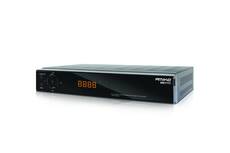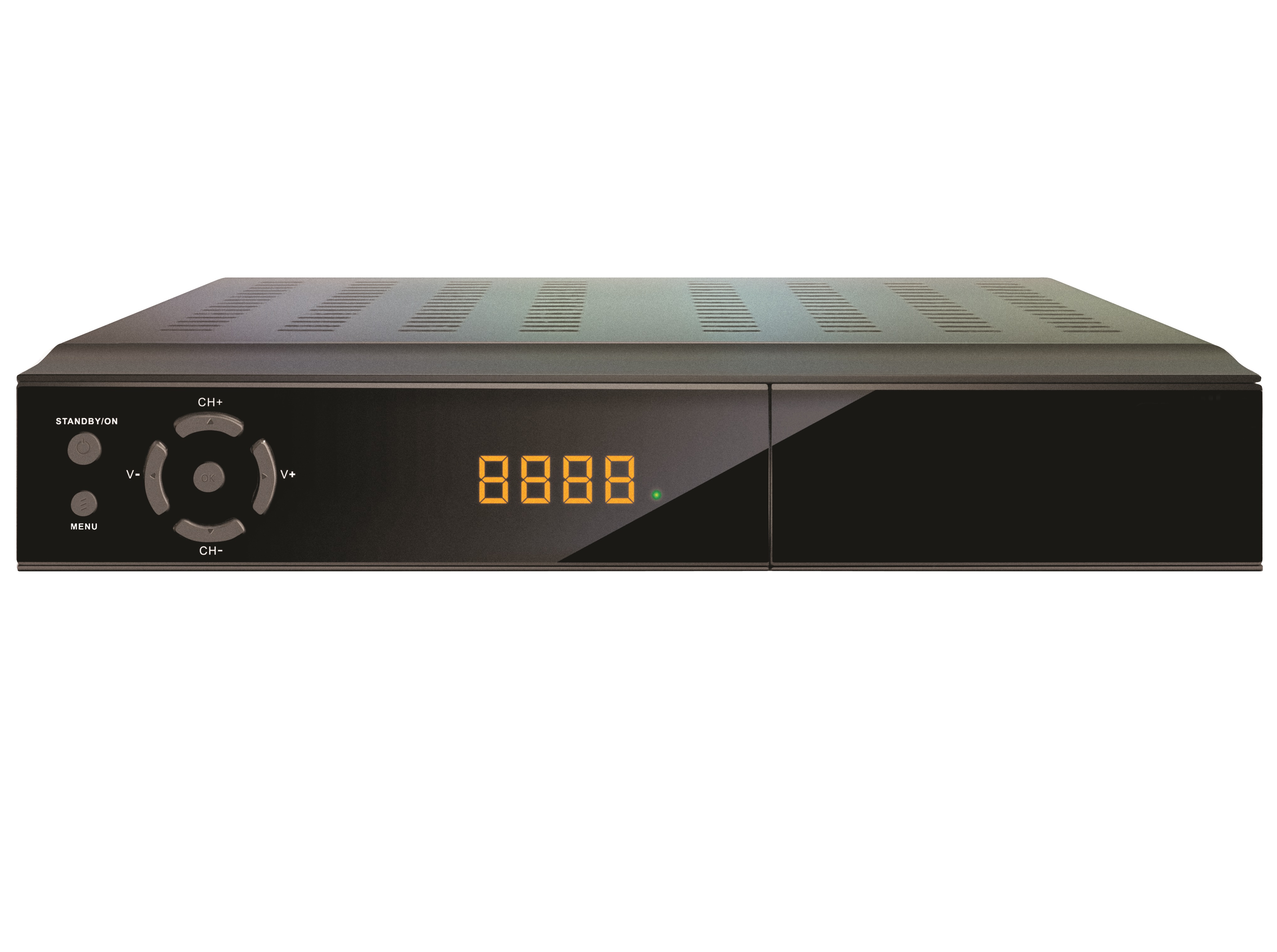Satellite Receiver
- further categoriesThe term DVB-S is often heard in connection with satellite television. What exactly does it mean? The abbreviation stands for Digital Video Broadcast - Satellite, which means satellite digital video transmission. It is also called digital satellite television. So we can receive not only digital terrestrial channels, but also digital television transmitters and radio stations. Read more...
• Full HD digital Satellite Receiver and Media Player
• Tuner Type: DVB-S / DVB-S2
• One Conax Embedded card reader
• H.265 HEVC decoding support
• S/S2 integrated Satellite tuner
• 6000 channels (TV and Radio) programmable
• MKV, AVI, MPEG, TS, VOB, MP3, JPEG playback
• One High Speed USB 2.0 Connections
• Ethernet Connection Support (Ralink RT5370 chip only)
• RSS Reader & Weather Forecast Functions (Ethernet connection required)
• DiSEqC 1.0, 1.1, 1.2 and USALS Compatible Satellite Receiver
• Full HD digital Satellite Receiver and Media Player
• Tuner Type: DVB-S / DVB-S2
• One Conax Embedded card reader
• H.265 HEVC decoding support
• S/S2 integrated Satellite tuner
• 6000 channels (TV and Radio) programmable
• MKV, AVI, MPEG, TS, VOB, MP3, JPEG playback
• One High Speed USB 2.0 Connections
• Ethernet Connection Support (Ralink RT5370 chip only)
• RSS Reader & Weather Forecast Functions (Ethernet or WiFi connection required)
• DiSEqC 1.0, 1.1, 1.2 and USALS Compatible Satellite Receiver
• Full HD digital Satellite Receiver and Media Player
• Upgraded with a processor for smoother operation
• Tuner Type: DVB-S2 Second Generation
• One Conax Embedded card reader
• H.265 HEVC decoding support
• 6000 channels (TV and Radio) programmable
• MPEG-2, MP@ML, MPEG-4 part 10/H264, H265/HEVC playback
• Two High Speed USB 2.0 Connections
• RSS Reader & Weather Forecast Functions (Ethernet or WiFi connection required)
• DiSEqC 1.0, 1.1, 1.2 and USALS compliant Satellite Receiver
• Full HD digital Satellite Receiver and Media Player
• Equipped with built-in WIFI
• Upgraded with a processor for smoother operation
• Tuner Type: DVB-S2 Second Generation
• One Conax Embedded card reader
• H.265 HEVC decoding support
• 6000 channels (TV and Radio) programmable
• MPEG-2, MP@ML, MPEG-4 part 10/H264, H265/HEVC playback
• Two High Speed USB 2.0 Connections
• RSS Reader & Weather Forecast Functions (Ethernet or WiFi connection required)
• DiSEqC 1.0, 1.1, 1.2 and USALS compliant Satellite Receiver
• 4K UHD digital satellite receiver and media player
• DVB-S/S2 tuner
• One Conax embedded card reader
• H.265 HEVC decoding support
• One S/S2 built-in satellite tuner
• 6000 channels (TV and radio) programmable
• MKV, AVI, MPG, MP4, TS, VOB, MP3, JPEG playback
• Two high speed USB 2.0 ports
• Ethernet connection
• TimeShifting support
• Video resolution: 720*480p/i, 720*576p/i, 1280*720p, 1920*1080p/i, 3840*2160p
What is DVB-S2 and why is it needed?
In 2005, the DVB-S2 standard was introduced, which is quite simply the successor to DVB-S. There are some important differences between DVB-S and DVB-S2 that should be taken into account when buying a satellite dish, and after all these years, it is the new standard that is worth using.
What is the difference between DVB-S and DVB-S2?
The difference is basically the higher data transmission speed. This can be seen in the large number of HD channels available via DVB-S2. Although it is technically possible to watch programmes in HD quality using DVB-S, most HD channels are only available via DVB-S2.
How do we know what standard our satellite receiver is working to? If we are not sure whether our satellite receiver is working to DVB-S or DVB-S2 standard, we only need to check our channel list. If you find a number of HD channels there, you are already using DVB-S2. However, if only a few HD channels appear in the channel list, you are probably still using DVB-S. In this case, it is time to act, because broadcasters have already started to phase out DVB-S. To receive all channels in the future, you will need a DVB-S2 compatible indoor unit.
What else do you need to receive DVB-S signals in addition to the satellite receiver indoor unit?
You will need a dish, an LNB, a satellite receiver indoor unit, which is already DVB-S2 compatible at best. If you already have a satellite dish system, you will only need a satellite receiver unit that is DVB-S2 compliant, or the DVB-S tuner integrated in your TV set will need to support the new standard. While DVB-S used to be free to receive both public and private channels, this is no longer the case with DVB-S2. If you want to watch RTL in HD quality, for example, you need to use a satellite receiver with a CI module. In addition, in order to watch encrypted channels, you will need an HD+ card, which enables the receiver to decrypt encrypted HD programmes.
How does the satellite receiver indoor unit work?
The central component of the satellite receiver system is the dish, or LNB. This head unit receives the satellite signals and converts the received signals into a frequency range of 950 - 2150 MHz. The converted signals are sent to the SAT receiver, which converts them into video that can then be displayed on the television.
What are the amenities of the satellite receiver indoor unit?
Telecom satellites can broadcast in HD or UHD, so you can use the indoor unit to select the channel that suits you, which can be pay-TV content. Through the satellite receiver, you can even access electronic programme guide (EPG) and parental lock functions for on-screen channel information. But unfortunately, there are no conveniences such as a video library.
Nowadays, you can also choose a USB WiFi antenna compatible set top box, which allows wireless internet connection. The advantage of this type of indoor unit is that it can receive not only full HD digital satellite TV, but also digital terrestrial and cable TV channels. But they can also help you to enjoy conveniences such as teletext, play exciting games or even watch your favourite series with subtitles.
What to know about card-reading SAT receivers
When comparing DVB-S receivers, we distinguish between two different types of satellite receivers. Those with a hard disk and those without a hard disk. Today's modern satellite receivers have a Ci or conax card reader, so they can play HD or HD Plus channels. A card reader is required to view encrypted satellite programmes (adult content, pay sports channels). If the receivers are also equipped with a USB port, you can also play videos and multimedia content from an external storage device.
Can we connect an indoor satellite receiver to our older TV?
Most satellite receivers can be connected to older analogue televisions. In this case, a Scart connector or antenna cable is what you need to make the connection.
We sell several brands and types of indoor satellite receivers, so if you have any questions about this, please do not hesitate to contact us!






